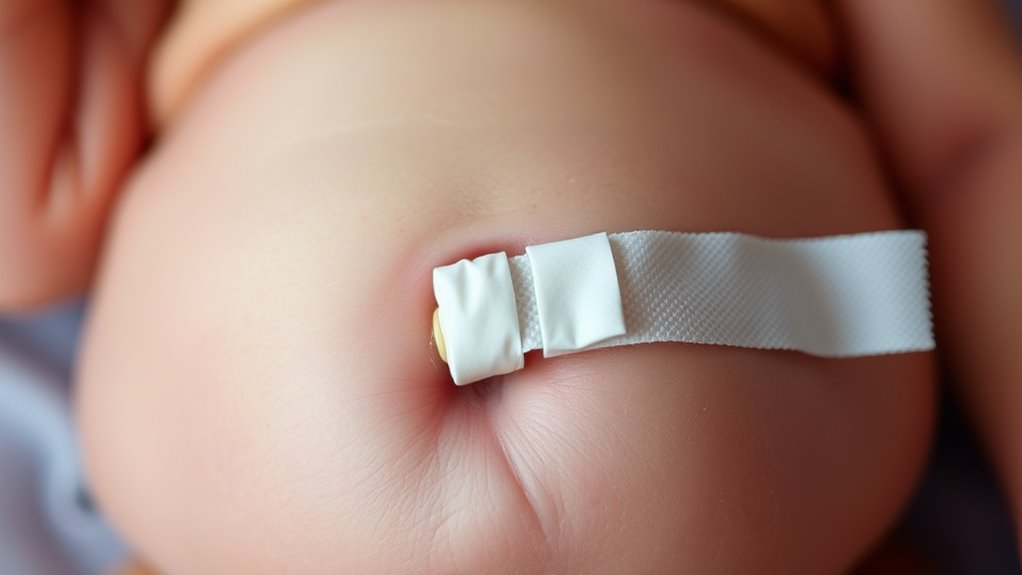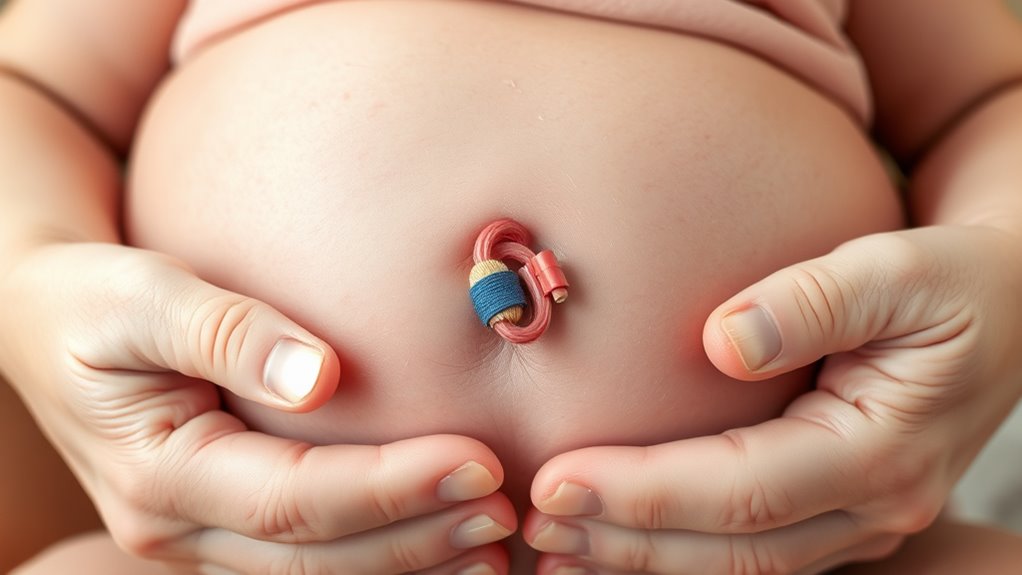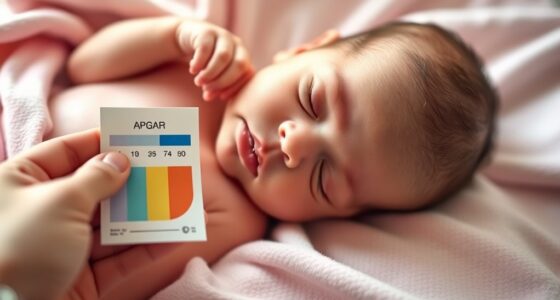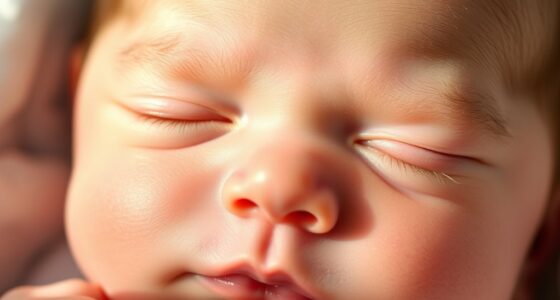To care for your baby’s umbilical cord, keep the area clean and dry, using plain water and a soft cloth for gentle cleaning. Avoid alcohol or antiseptics unless advised by a healthcare provider. Allow the cord to fall off naturally in about 1-3 weeks, and watch for signs of infection like redness, swelling, or foul smell. Proper clothing and diaper management help prevent irritation. Continue exploring for more tips on keeping the area safe and healthy.
Key Takeaways
- Keep the umbilical area clean and dry, using plain water and a soft cloth for gentle cleaning.
- Allow the cord to fall off naturally within 1-3 weeks without pulling or forcing it.
- Avoid applying alcohol, powders, or lotions; keep the area exposed to air for healing.
- Dress the baby in loose, breathable clothing and fold the diaper below the cord to prevent irritation.
- Watch for signs of infection such as redness, swelling, foul smell, or pus, and consult a healthcare provider if needed.

Have you ever wondered how to properly care for your newborn’s umbilical cord? It’s a common concern for new parents, and knowing the basics can make you feel more confident during those early days. The primary goal is to keep the area clean and dry to promote healthy cord separation and prevent infection. The umbilical cord typically falls off on its own within one to three weeks after birth, but how you care for it during that time matters. Proper umbilical cord care involves gentle cleaning, avoiding unnecessary moisture, and being vigilant about signs of infection.
When it comes to cord separation, patience is essential. You might notice the cord turning darker and shrinking as it dries out, which is completely normal. To support this process, keep the area clean without overdoing it. Use plain water and a soft cloth to gently clean the base if it gets dirty or sticky. You don’t need to use alcohol or antiseptics unless your healthcare provider advises otherwise. Avoid submerging the baby in a tub until the cord falls off and the area heals completely. Instead, give sponge baths, taking care to keep the umbilical cord dry.
Infection prevention is vital, so you should be vigilant for any signs of trouble. If you see redness spreading around the base, swelling, a foul smell, or pus, seek medical advice promptly. These symptoms may indicate an infection that needs treatment. Be cautious about clothing too—dress your baby in loose, breathable garments that don’t rub against the cord stump. This helps air circulate and keeps the area dry, which is essential for cord separation and minimizing infection risk.
It’s also a good idea to keep the diaper folded below the cord level so urine doesn’t come into contact with the stump. This simple step helps maintain dryness and reduces the chance of irritation or infection. Remember, you don’t need to apply powders or lotions to the umbilical area; these can sometimes cause irritation or interfere with natural healing. Regular, gentle cleaning and keeping the area exposed to air as much as possible are your best strategies.
Additionally, the integration of AI in healthcare is increasingly supporting better outcomes and providing guidance for new parents during this delicate period.
Patience and consistent care are your best tools in ensuring your baby’s umbilical cord heals properly. With proper attention to cord separation and infection prevention, you’re helping your newborn heal comfortably and reducing the risk of complications. Trust your instincts, follow your healthcare provider’s advice, and soon enough, that tiny cord stump will fall off, leaving behind a healthy, healed belly button.
Frequently Asked Questions
When Should I Call the Doctor About the Cord Stump?
You should call the doctor if you notice any signs of infection or unusual odor coming from the cord stump, or if it becomes red, swollen, or oozes pus. Also, contact the doctor if the cord doesn’t fall off within three weeks or if your baby seems irritable or develops a fever. Promptly addressing these issues can prevent complications and guarantee your baby’s healing process stays on track.
Can I Bathe My Baby With the Cord Still Attached?
Think of your baby’s cord as a tiny, delicate seed that needs careful watering. You shouldn’t bathe your baby with the cord still attached because it’s like exposing that seed to too much water too soon. For proper cord hygiene, wait until it falls off and heals. During this time, stick to sponge baths and avoid submerging the cord in water to prevent infection and promote safe healing.
Are There Any Signs of Infection to Watch For?
You should watch for signs of infection during cord healing, like redness, swelling, foul odor, or pus around the site. If your baby’s skin becomes hot or the area feels tender to the touch, these are also signs to look out for. Keep the area clean and dry, and if any of these signs appear, contact your pediatrician promptly to prevent complications and ensure proper healing.
How Long Does It Take for the Cord to Fall Off?
You can expect the cord to fall off within one to three weeks after birth. During this time, you’ll notice the cord drying out and turning darker as it prepares to fall off. Keep the stump clean and dry to promote proper stump healing. Avoid pulling at the cord, and watch for signs of infection. Once it falls off, continue caring for the area until it fully heals.
Is It Safe to Use Alcohol or Wipes on the Cord?
It’s generally safe to use alcohol or wipes on your baby’s cord, but you should be cautious about maintaining cord cleanliness without causing skin irritation. If you choose to use alcohol, do so sparingly and ensure it dries completely to prevent irritation. Wipes can be used if they are gentle and alcohol-free. Always follow your healthcare provider’s advice, and watch for signs of redness or swelling that could indicate infection.
Conclusion
Taking good care of your baby’s umbilical cord helps prevent infection and ensures a smooth healing process. Keep the area clean and dry, and don’t rush to remove the cord stump prematurely. Remember, patience is a virtue—what you do now sets the foundation for your little one’s health. Trust your instincts, stay attentive, and you’ll get through this stage with flying colors. Every small effort pays off in giving your baby the best start in life.







